Our journey North continues, but first, we had breakfast at the Pailyn Hotel Phitsanulok breakfast buffet. This time, I resolved not to be late, so I would not go hungry as we explore the local temples. But perhaps it would have been better to miss: the rice porridge had cooled, so when I poured it over the fried egg with still wiggly whites, it failed to finish the job of cooking the egg. Oh well, what’s the worst thing that could happen?
Our first temple was Wat Phra Si Rattana Mahathat, a complex of numerous interconnecting buildings located along a river. Its scale explains its nickname: Wat Yai, meaning Large Temple. We began outdoors with an impressive standing Buddha statue. The chedi (in other countries known as a stupa), said to contain a relic of the Buddha, is a prang built in the Khmer style. Gilded with gold, it shone beautifully in the morning sun. Inside, there is a bronze Buddha image cast in the Sukhothai style which is considered among the most beautiful and important in Thailand. One of its more unusual features is the “aura” or “halo” of flames around not just the head but both sides of the body; I don’t recall seeing that elsewhere in Thailand, but since these are made of painted wood rather than metal, it could be that most simply were not preserved. We walked across the street to a smaller temple and viewed a replica there, but comparing the faces, you can see that the maker of the replica was not as skilled at portraying the very graceful, peaceful, almost super-human ideal of the period.
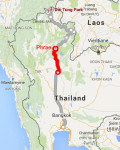 We left town without visiting any other attractions because we wanted to hit our lunch spot early. Situated along the highway between Phitsanulok and Phrae, Lomyen is large restaurant popular with Thai tourists, large busloads of which would arrive toward the end of our meal. With its own artificial waterfall and surprisingly elegant outdoor bathrooms, you could see a lot of work went into making this a “must eat” place. When the first of our food arrived, it was good, but nothing to make you drive out of your way. A green curry with chicken and Thai eggplants was so shockingly green in color I suspect a juicer was involved, but the flavor was just about average. A spicy seafood stir-fry was par for the course, and a stir-fry of mung bean threads (also known as crystal noodles) and vegetables was tasty and comforting. The fried mackerel served with a spicy dipping sauce with the strong flavor of fermented shrimp paste (nam prik kapi) could be the country’s favorite dish, and this was an excellent version. But the real excitement began when we receiving a heaping plate of deep fried fish fillets topped with innumerable deep fried lemongrass threads and a few crispy fried kaffir lime leaves. At once moist on the inside and crispy outside, these are among the best fried fish fillets I can remember eating, and the combination with lemongrass and a bracing garlicky dipping sauce was positively addictive. I might have eaten half the plate. And then, representing a completely different style of cooking, we had chunks of long-stewed pork leg. The star anise had penetrated the now-tender skin and fat to flavor the meat itself. It was a decadent treat. With specialties like these, one can see why Lomyen is the proverbial “Nut Tree” of this underdeveloped stretch of highway.
We left town without visiting any other attractions because we wanted to hit our lunch spot early. Situated along the highway between Phitsanulok and Phrae, Lomyen is large restaurant popular with Thai tourists, large busloads of which would arrive toward the end of our meal. With its own artificial waterfall and surprisingly elegant outdoor bathrooms, you could see a lot of work went into making this a “must eat” place. When the first of our food arrived, it was good, but nothing to make you drive out of your way. A green curry with chicken and Thai eggplants was so shockingly green in color I suspect a juicer was involved, but the flavor was just about average. A spicy seafood stir-fry was par for the course, and a stir-fry of mung bean threads (also known as crystal noodles) and vegetables was tasty and comforting. The fried mackerel served with a spicy dipping sauce with the strong flavor of fermented shrimp paste (nam prik kapi) could be the country’s favorite dish, and this was an excellent version. But the real excitement began when we receiving a heaping plate of deep fried fish fillets topped with innumerable deep fried lemongrass threads and a few crispy fried kaffir lime leaves. At once moist on the inside and crispy outside, these are among the best fried fish fillets I can remember eating, and the combination with lemongrass and a bracing garlicky dipping sauce was positively addictive. I might have eaten half the plate. And then, representing a completely different style of cooking, we had chunks of long-stewed pork leg. The star anise had penetrated the now-tender skin and fat to flavor the meat itself. It was a decadent treat. With specialties like these, one can see why Lomyen is the proverbial “Nut Tree” of this underdeveloped stretch of highway.
We took a detour before reaching Phrae to visit a temple that Kasma described as “huge” (in scale, not in importance). In fact, Wat Phra That Suthon Monkhon Khiri is completely over the top in the size of its statuary, to the point that its operators seem unable to keep up with the damage caused by the relentless sun. We challenged ourselves to frame photos around the long reclining Buddha, enormous Singha statues (the mythical creatures, not the well-known Thai beer), three-story-tall Buddha figures, and other outsized monuments. We also gaped at the riches of the small museum here, such as the lids of monks’ alms bowls, usually a modest bronze, here inlaid with mother-of-pearl. (Sadly, no photos were allowed.)
Finally, we headed into town to the Poomthai Garden Hotel, built around a swimming pool with a small lawn and some tropical plants (I think this is the garden they are referring to). Since we are here for three nights, we can finally have a happy hour including our Thai drivers. We had liquor contributions from Scotland (100 Pipers, a Thai favorite), Ireland (Jamisons) and Mexico (Olmeca Altos), along with ice and sparkling water. Our snacks ranged from a delicious home made beef jerky and Southern Thailand cashews roasted in their skins (the husk-like skin is edible but not particularly tasty), to deep fried crickets we bought at a gas station convenience store. The crickets had a soft, uniform texture with no unpleasant bits and tasted like pepitas. For best results, I recommend not actually looking at them before eating them.
Soon it was time for dinner, and we headed to the oddly named New MenuPla (“new fish menu”) restaurant, whose road sign features a fish formed from bright white neon tubes. True to the name, our meal consisted mostly of fish dishes: steamed whole fish in a rich broth, fried catfish steaks, fried fish fillets, and fishball and squid larb. A salad of shredded banana blossoms with shrimp, and stir-fried segments of long green eggplant with ground pork were the exceptions. Since the steamed fish had a very mild flavor, I found a good combination was to serve the eggplant dish right on top of it. But no matter your preference, there was plenty to go around because they served much larger portions than we had seen in other towns.
Back at the hotel, a wedding party was loudly rehearsing its upcoming reception. Still, I had no difficulty passing out. Perhaps I need to eat a little less tomorrow.
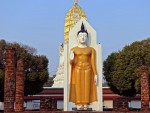
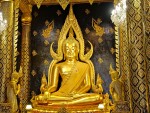
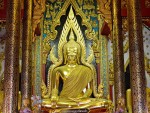
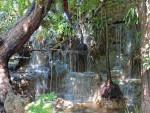
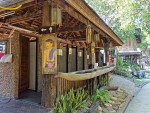
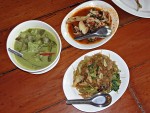
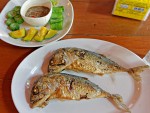
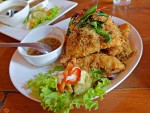
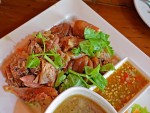
Sorry, the comment form is closed at this time.